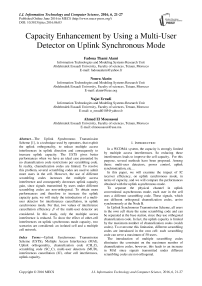Capacity Enhancement by Using a Multi-User Detector on Uplink Synchronous Mode
Автор: Fadoua Thami Alami, Noura Aknin, Najat Erradi, Ahmed El Moussaoui
Журнал: International Journal of Information Technology and Computer Science(IJITCS) @ijitcs
Статья в выпуске: 6 Vol. 8, 2016 года.
Бесплатный доступ
The Uplink Synchronous Transmission Scheme [1], is a technique used by operators, that exploit the uplink orthogonality, to reduce multiple access interferences in uplink direction and consequently to increase uplink capacity. The USTS gives better performances when we have an ideal case presented by no channelization code restrictions per scrambling code. In reality, channelization codes are limited. To resolve this problem, several scrambling codes are used to admit more users in the cell. However, the use of different scrambling codes increases the multiple access interference and consequently decreases uplink capacity gain, since signals transmitted by users under different scrambling codes are non-orthogonal. To obtain more performances and therefore to increase the uplink capacity gain, we will study the introduction of a multi-user detector for interferences cancellation, in uplink synchronous mode. For that, two values of interference cancellation efficiency of the multi-user detector are considered. In this study, only the multiple access interference is reduced. To show the effect of other-cell interferences on uplink synchronous mode capacity, two scenarios are considered: an isolated cell and a multiple cell network.
Uplink Synchronous Transmission Scheme (USTS), Multiple Access Interference (MAI), Uplink orthogonality, channelization code (CH_C), scrambling code (SC_C), multi-user detectors (MUD), interferences cancellation (IC), other cell interferences, uplink capacity
Короткий адрес: https://sciup.org/15012494
IDR: 15012494
Текст научной статьи Capacity Enhancement by Using a Multi-User Detector on Uplink Synchronous Mode
Published Online June 2016 in MECS
In a WCDMA system, the capacity is strongly limited by multiple access interferences. So reducing these interferences leads to improve the cell capacity. For this purpose, several methods have been proposed. Among them: multi-user detectors, power control, uplink synchronization, etc…
In this paper, we will examine the impact of IC receiver efficiency, on uplink synchronous mode, in terms of capacity, and we will compare the performances obtained with the uplink asynchronous mode.
To separate the physical channel in uplink conventional asynchronous mode, each user in the cell uses a different scrambling code. These signals, which use different orthogonal channelization codes, arrive synchronously at the Node B.
In Uplink Synchronous Transmission Scheme, all users in the own cell share the same scrambling code and can be separated at the base station, since they use orthogonal channelization code. In fact, the uplink capacity is limited by the maximum number of channelization codes (walsh codes). To overcome this limitation, different scrambling codes are introduced in the own cell: each scrambling code can serve a maximum of 50 users.
The introduction of multiple scrambling codes eliminates the constraint on the maximum number of channelization codes, however, this leads to an increase in MAI since signals transmitted under different scrambling codes are not orthogonal.
This paper is organized as follows. Sections II discuss the effect of MUD receiver on the uplink conventional asynchronous mode. A theoretical analysis of the capacity and the effect of other cell interferences, when MUD receiver is introduced in uplink synchronous mode, are presented in section III. Simulation results and discussions are presented in section IV. Concluding remarks are discussed on section V.
E b W Pr , i
N 0 R i P n + P own f uL + ( P own - P i )(1 - P )
Consequently:
P
(1 — P + f uL ) P own + P n
w
—+ (1 - P )
E b R
N 0
II. Application of Mud Receiver on Uplink Asynchronous Mode
The minimum quality of service, E b /N 0 , required for a user ( i ) in uplink direction [2], without using a multi-user detector MUD [3, 5, 9, 12, 14, 17], for interferences cancellation IC [4, 10, 11, 13], can be expressed as:
With:
P own
E b W Pr , i
N 0 R . P n + (1 + fuL ) P own - P r , i
Where:
N
PNZ w7
i = 1
N E b 0 ) i R i v i
N
1 (1 + fUL ) Z, i=1 E
N E b 0 ) i R i v i
P r, i is the received power from the user ( i ), at the Node B
The received power of the mobile station at the Node B is expressed as:
W is the chip rate.
R is the bit rate.
P
P N f
Л
N is the number of users in the cell.
Pown is the total intracellular received power at the Node B. It depends on user’s distribution in the cell and on the propagation conditions.
W
Eb- ). Rv. к N о i
+ (1 - P )
P N is the thermal noise power at the Node B.
fuL =
p Z ^j
P other j =1 _____
is the other to own cell
P own
N
Z Pr i=1
interference factor.
Pr, j is the received power at the Node B, for a user ( j ) connected to another base station.
P other is the total received power at the Node B, from users connected to neighboring cells in uplink direction. In fact, there is a big difference between Uplink and downlink inter-cell interference. The value of inter-cell interference in Uplink, is the same for all users in the same cell, as their receptors are located in the Node B. However, in downlink, a user located far from the Node B receives more inter-cell interference that one located near to the Node B.
Suppose that, after applying the IC receiver, we can eliminate a β fraction of intracellular interference seen by a given user, anywhere, where 0 < P < 1 , [15]. P = 0 represents no interferences cancellation and P = 1 represents perfect cancellation of interferences.
At the reception level, the link quality equation becomes:
N
1 -Z i =1
к
(1 - P + f uL )
w
—+ (1 - P )
Eb ) Rv
N 0 i i i
And the cell loading factor [16, 18, 19], calculated as:
N nuL = (1-P +fuL )Z -------- i=1 VW—+(1-P)
Eb ) R v N 0 ) i R i v i
Therefore, the Noise Rise factor will be:
NR = —1—
1 - R ul
1 - (1 - P + f uL )--------
(1 - P ) + £-------
N E b 0 ) i R i v i
can
be
-
III. Application of Mud Receiver on Uplink Synchronous Mode
-
A. Case of a multi-cell network
In uplink synchronous mode, the link quality equation can be expressed as [6, 7, 8]:
Where,
E b p syncj
N 0 P ot - Nj P yncj a
nuL = (1 + fUL >£ -V---- j=1 /.+ a
Eb RN N 0 j
p : is the received power from a user under a syncj scrambling code j.
P : is the total received power at the base station.
N : is the number of users under a scrambling code j.
a : is the uplink orthogonality factor.
When MUD receiver is introduced in synchronous uplink direction, the link quality equation becomes:
E b p syncj
N 0^ (1 - в + f UL ) P own - (1 - в ) N j P syncj a + P n
By following the same stapes presented in section 2, the Noise Rise can be calculated as:
Where,
P ot = (1 + fUL ) P own + Pn (9)
And, p„.=1лр,„„ (10)
j = 1
NR =------------- 1----
1 - (1 - в + fUL )^--SF j =1 ___W
Eb RN
N 0
And the cell loading factor is:
+ a (1 - в
From equation (8), the following expression is obtained:
J
VUL = (1 — в + fUL )£ j=1
p syncj
N
W
'---+ a (1 - в )
Eb RN
N 0 j
Consequently,
P own
W
-=—+ n a
E b R j
N 0
J
P N
^ W j=1
Eb RN
N0
| J (1 + f UL )
j=1
E b RN
N0
B. Other cell interferences effect on uplink capacity
In this section we will compare the Noise Rise factor obtained in two scenarios: an isolated cell and a multicell network. In the case of a multi-cell network scenario, the expression of NR is presented in equation (17). Therefore, in the case of an isolated cell, when f^ = 0 , the NR is given by:
NR
Since the Noise Rise factor is written as:
J
-
1 - ^ W
-
-' =1 -=+ a
Eb RN
N J
N 0
p NR = ■
P N
When MUD receiver is used, NR factor becomes:
Therefore, for a synchronous mode scenario, the last expression becomes:
NR =--------- j----1-----;---------
1 - (1 - в )Е ^-----------
J = 1 -FF W ----+ a (1 - в )
Eb RN
N 0 j
NR =--------- У"
1 - (1 + fUL )Z j=1
W
—--+ a
Eb RN
N 0 j
Consequently, the cell loading factor is:
IV. Simulation and Results
We have considered in this study a micro cellular environment with the following parameters:
R =12.2 kbit/s, E b /N 0 =5dB, v =0.67, f UL =0.67, α = 0.6 .
Figure 1 illustrates the Noise Rise factor as a function of the number of users for three modes: asynchrone, synchrone with no CH_C restrictions per scrambling code and synchrone with a maximum of 50 users per scrambling code.
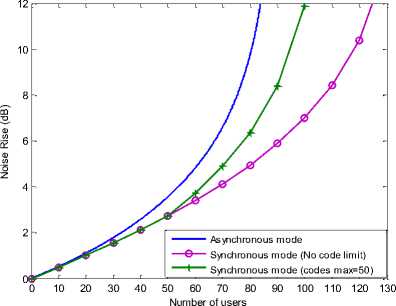
Fig.1. Variation of Noise Rise factor as a function of the number of users for asynchronous and synchronous modes
From this figure, we can note that, the Noise Rise in the case of asynchronous mode increases rapidly, while it increases slower in the case of synchronous mode. The two curves of synchronous mode are identical up to 50 users, however, above 50 users, it is observed that the Noise Rise in the synchronous mode with a maximum of 50 users per scrambling code increases much faster than the case of synchronous mode with no code restrictions. This difference is due to the increase of multiple cell interferences MAI when using different scrambling codes, since the orthogonality factor is not obtained in this case.
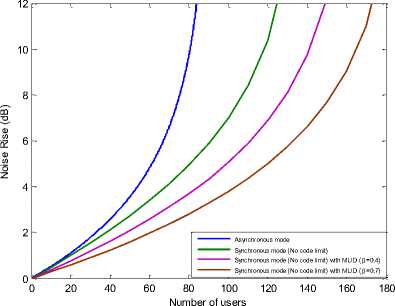
Fig.2. Variation of Noise Rise factor as a function of the number of users for asynchronous mode and synchronous mode with no CH_C restrictions, without and with application of MUD.
The figure 2 shows the variation of Noise Rise as a function of the number of user, for a conventional asynchronous mode, and for synchronous mode when no codes restriction is considered, with and without introducing MUD receiver.
According to figure 2, it is observed that, for to NR=4 dB, the cell capacity obtained in a synchronous mode is better than the one obtained in a conventional asynchronous mode. In addition, the introduction of MUD receiver with a high value of β gives better performances, and the capacity gain increases.
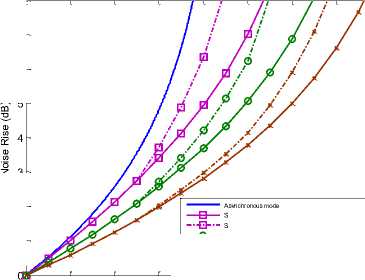
Asynchronous mode
Number of users
Synchronous mode (codes max=50)
Synchronous mode (No code limit) with MUD(β=0.4)
—о— Synchronous mode (codes max=50) with MUD(β=0.4)
It Synchronous mode (No code limit) with MUD(β=0.7)
-•-<-•- Synchronous mode (codes max=50) with MUD(β=0.7)
Fig.3. Comparison of Noise Rise factor as a function of the number of users for asynchronous mode and synchronous mode with no CH_C restrictions and with a maximum of 50 CH_C per scrambling codes, without and with application of MUD for two values of β .
In reality, the maximum number of CH_C per scrambling code is limited, thus, a maximum of 50 users is affected for each scrambling code. We compare in figure 3, the capacity obtained when we have a maximum number of CH_C per scrambling code, with the one obtained when we have no constraint on the maximum number of synchronized UEs per scrambling code, for different scenarios.
It can be noticed that, above 50 users, the capacity obtained in the case of synchronous mode with codes restrictions is lower than the one obtained in an ideal case. That is true for the two scenarios: with and without MUD receiver.
In addition, the best capacity is obtained when a MUD receiver is considered with a value of β = 0.7 .
During the planification phase, mobile operator can determine the uplink cell capacity basing on the Noise Rise factor or the cell loading factor.
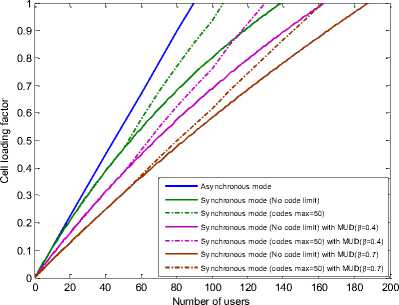
Fig.4. Comparison of cell loading factor as a function of the number of users for asynchronous mode and synchronous mode with no CH_C restrictions and with a maximum of 50 CH_C per scrambling codes, without and with application of MUD receiver for two values of β .
The results related to figure 4, show that, for n = 0.6 , we have the same interpretation seen in the Noise Rise figure.
In figure 5, we have compared the effect of a MUD on a conventional asynchronous mode and on the two cases of synchronous mode: with and without CH_C code restriction.
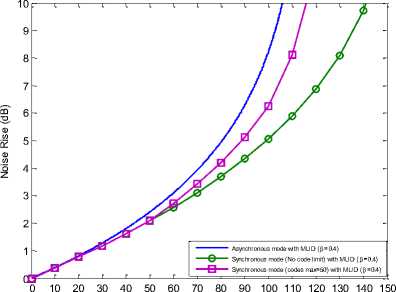
Number of users
Fig.5. Comparison of Noise Rise factor as a function of the number of users when a MUD receiver is introduced on asynchronous mode and in the two cases of synchronous mode.
Simulation results demonstrate that the Noise Rise in a conventional asynchronous mode, increases faster than the Noise Rise obtained in the two cases of synchronous mode, with application of MUD receiver. Above 50 users, the gain of capacity is more important when no constraint on maximum synchronous users per scrambling code is considered. Consequently, the application of MUD receiver in the ideal case of synchronous mode is more efficient than in the case of asynchronous mode.
To illustrate the effect of other cell interferences on uplink capacity in synchronous mode, we represent in figure 6, the variation of Noise Rise factor as a function of the number of users for two scenarios: an isolated cell and a multiple cells network.
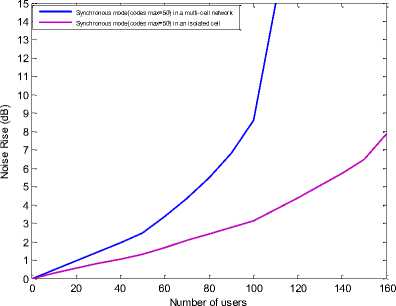
Fig.6. Effect of other cell interferences on Noise Rise factor, in uplink synchronous mode, when a maximum of 50 synchronized users per SC C is considered.
From this figure, we denote that for a given value of NR, the cell capacity attained in the case of a multi-cell network is very low in comparison with the one obtained in the case of an isolated cell. This means that the othercell interferences have a negative effect on uplink capacity in synchronous mode. That is due to the fact that only the own cell interferences is reduced on uplink synchronous mode, and as a result, the gain of capacity decreases when the other cell interferences become dominant.
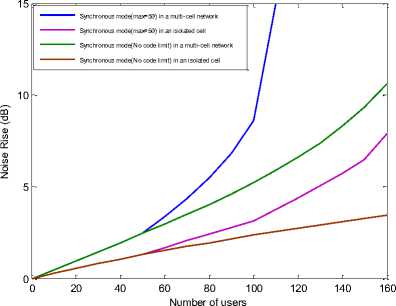
Fig.7. Comparison of the effect of other cell interferences on Noise Rise factor, in the two cases of uplink synchronous mode.
For the two types of uplink synchronous mode, we notice according to figure 7 that, above 50 users, the biggest capacity is the one obtained in the case of no constraint on the maximum number of synchronous users per scrambling code, when an isolated cell is considered. When a MUD receiver is introduced, we can deduce from figure 8 that the biggest capacity is the one obtained with в = 0.7 , in the case of an isolated cell.
Synchronous mode with MUD(beta=0.4) in a multi-cell network in in in
Synchronous mode with MUD(beta=0.7) i
Synchronous mode with MUD(beta=0.7) i an isolated cell a multi-cell network an isolated cell
E
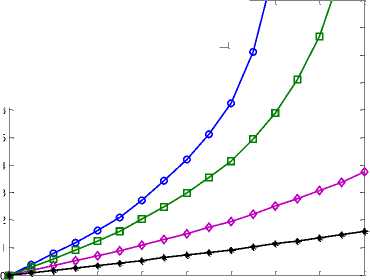
Number of users
Fig.8. Comparison of the effect of other cell interferences on Noise Rise factor, in the two cases of uplink synchronous mode, when a MUD receiver is introduced.
-
V. Conclusion
In this paper, we have studied the effect of the uplink synchronous mode on the uplink capacity in comparison with a conventional asynchronous mode. We have shown that in uplink synchronous mode with no channelization codes restrictions per scrambling code, we get better performances in terms of capacity.
In addition, we have studied the impact of a MUD receiver on uplink synchronous mode. We have noticed that in comparison with it application on an asynchronous mode, the introduction of MUD on synchronous mode gives better capacity. The performances of MUD receiver and thus the capacity gain increases when the value of β is higher.
On the other hand, we have studied the effect of the other cell interferences on uplink capacity for a synchronous mode. The simulation results showed that the gain of capacity decreases when the other cell interferences become dominant.
Список литературы Capacity Enhancement by Using a Multi-User Detector on Uplink Synchronous Mode
- 3GPP TR 25.854 V5.0.0 (2001-12), 3rd Generation Partnership Project, Technical Specification Group Radio Access Network; Study Report for Uplink Synchronous Transmission Scheme (USTS); (Release5), [Online], Available: www.3gpp.org
- Fadoua Thami Alami, Noura Aknin, Ahmed El Moussaoui, Uplink Capacity Estimation and Enhancement in WCDMA Network, I.J. Information Technology and Computer Science, 2013, 09, 21-30, 2013.
- M.A.Hernandez, G.J.M.Janssen, R.Prasad, Uplink performance enhancement for WCDMA systems through adaptive antenna and multiuser detection, Delft Univ. of Technol., Netherlands Dept. of Electr. Eng. Vehicular Technology Conference Proceedings 1: 571 – 575, 2000.
- D.Dahlhaus,Zhenlan Cheng, Smart antenna concepts with interference cancellation for joint demodulation in the WCDMA UTRA uplink, 6th International Symposium on Spread Spectrum Techniques and Applications 1: 244 – 248, 2000.
- S.Hamalainen, H.Holma, A.Toskala, Capacity evaluation of a cellular CDMA uplink with multiuser detection, International Symposium on Spread Spectrum Techniques and Applications, 1: 339-343, 1996.
- Mridula S. Korde and Abhay S. Gandhi, A New Technique for Capacity Enhancement in WCDMA Uplink with Synchronization, Lecture Notes on Information Theory, Vol. 2, No. 1, pp. 98-104, March 2014.
- Mridula S. Korde and Abhay S.Gandhi, Effect of Synchronization on Uplink Capacity Enhancement of WCDMA, Journal of Information and Communication Technologies, ISSN 2047-3168, Vol. 3, Issue 3, March 2013.
- Outes Carnero, José,Uplink Capacity Enhancement in WCDMA,Multi Cell Admission Control, Synchronised Schemes and Fast Packet Scheduling, Ph.D. Thesis,ISBN 87-90834-54-2,ISSN 0908-1224, March 2004.
- Camilo Orejuela Mesa, WCDMA, Enhanced Uplink performance evaluation, Master of Science in Telematics, thesis, May 2006.
- B.Hagerman, F.Gunnarsson, H.Murai, M.Tadenuma, J.Karlsson, WCDMA uplink interference cancellation performance - Field measurements and system simulations, Nordic Radio Symposium, 2004.
- T.Futami, H.Seki, Y.Tanaka, Performance evaluation of DS-CDMA multistage interference canceller in multi-cell environments, Fujitsu Labs. Ltd. Global Telecommunications Conference 1: 247-252, 1998.
- S.Hamalainen, H.Holma, A.Toskala, Capacity evaluation of a cellular CDMA uplink with multiuser detection, International Symposium on Spread Spectrum Techniques and Applications, 1: a339-343, 1996.
- Cai Meng, Xi Zhang, Ning Zhou, Slimane Ben Slimane, On the capacity of CDMA with linear successive interference cancellation, Sensors, & Syst., R. Inst. of Technol. Dept. of Signals, 5th European Personal Mobile Communications Conference: 362-366, 2003.
- Hernandez, M.A., Janssen, G.J.M., Prasad, R. Uplink performance enhancement for WCDMA systems through adaptive antenna and multiuser detection, Vehicular Technology Conference Proceedings, 2000. VTC 2000-Spring Tokyo. 2000 IEEE 51st, pp.571 - 575 vol.1.
- Parveen Singla, Jyoti Saxena, Enhanced Capacity Analysis in WCDMA System, International Journal of Electronics and Communication Engineering.ISSN 0974-2166 Volume 4, Number 1 (2011), pp.69-82.
- E.J.B. Rodrigues, Uplink Throughput Enhancements and Delay Reductions in 3G WCDMA Systems Using 3.5G Enhanced Uplink Techniques, Spread Spectrum Techniques and Applications, 2006 IEEE Ninth International Symposium on, 28-31 Aug. 2006,pp:223 - 227.
- Zhenning Shi, Ming Zhao, He Wang, Mark C. Reed, On the uplink capacity and coverage of relay-assisted UMTS cellular network with multiuser detection, Wireless Communications and Networking Conference (WCNC), 2012 IEEE, pp:2979- 2983, ISSN:1525-3511, 1-4 April 2012.
- Ojemeni Uzoma, Correlation between Uplink Noise, Uplink Load and Call Drop Rate in a WCDMA Network, International Journal of Computer Applications (0975 – 8887), Volume 66– No.5, March 2013.
- Prof.K.Ayyappan, Dr R.Kumar, Impact of Convolutional Code on Uplink Performance of WCDMA Network using Utility based CAC Scheme with Different Decision Decoders, International Journal of Wireless and Mobile Networking (IJWAMN), Vol. 1, No. 1, November 2013.

